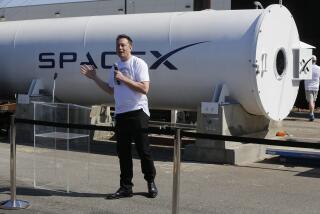Merging With Rival May Assure Survival During a Downturn
Like most entrepreneurs, Prime Time Shuttle founder John Kindt searched hard to find an investor. Kindt’s angel, who was in the construction business, fueled Prime Time’s growth by providing the money to install a high-tech computer reservation system. Soon, the company, which serves airports, piers and train stations in Los Angeles and Orange counties, ranked second among shuttle services in Southern California.
But a few months ago, when the region’s construction boom fizzled, Kindt’s angel pulled out, asking Kindt to convert his substantial equity investment into a loan.
“I had to decide whether to pull way back and resign my position as No. 2 in the industry, or go forward and turn into the storm,” said Kindt, who founded the company in 1986.
Cutting back was too depressing. Selling out would be a defeat. As he weighed his alternatives, Kindt recalled an earlier overture made by a rival, City Shuttle founder Rod Ramsey. Kindt and Ramsey had served together on the board of a shuttle industry trade association. Although they competed for every passenger in the San Fernando Valley, the two respected each other’s operations.
While the thought of joining forces with your enemy may be hard to swallow, more small-business owners are using mergers or strategic alliances as a way to flourish during the current economic slowdown.
“It is much more difficult for companies to remain independent and grow in a recession,” said Jim Freedman, managing director of Barrington Associates, a Brentwood investment banking firm. “In these times, companies need size, bargaining power, increased distribution and decreased costs.”
If your company is not ranked No. 3 or better in its industry, you should think of making some kind of alliance with a competitor, said Michael Corrigan, head of Price Waterhouse’s corporate finance group in Los Angeles.
“In any recession, the weakest tend to go to the wall,” said Corrigan, who along with Phil Tremonti, another partner at Price Waterhouse, orchestrated the Prime Time-City Shuttle merger.
When Kindt and Ramsey began negotiating in July, Tremonti said they were far apart.
“They walked away from each other three or four times,” Tremonti said. “I felt like a priest or marriage counselor.”
Tremonti, who has put together several mergers, said the biggest problem in bringing two small companies together is meshing the needs of their strong-willed owners. “While I was using financial logic, the entrepreneurs let their egos get in the way,” he said.
Slowly, he encouraged Kindt and Ramsey to focus on the positives of a deal, emphasizing growth potential and ability to cut overhead.
Eventually, Tremonti, the entrepreneurs, their accountants and attorneys crafted a merger plan. The division of responsibility reflected their personal strengths. Kindt, who became president of the combined firm, realized he enjoyed overseeing day-to-day operations. Ramsey, vice president and chief financial officer, prefers to concentrate on the financial and administrative side of the business.
Prime Time hired a number of City Shuttle’s drivers, bringing employment to 500, but many others were let go.
To give the new and bigger Prime Time a fresh start and more space, the company recently moved into a 15,000-square-foot facility near Burbank Airport.
Shortly after moving into the new headquarters, Ramsey, who also founded his shuttle company in 1986, reflected on his decision to join Prime Time.
“I approached John and told him it made sense for us to get together,” he said. “At first, he wasn’t too receptive, but then he became convinced it was a good idea.”
As the company gears up for the busy holiday travel season, Ramsey said, he can already see how the merger has substantially reduced overhead costs.
“This merger will contribute to our profits and allow us to survive the hard times,” he said.
Kindt also feels good about the merger.
“I eliminated a competitor,” he said. “The merger gives us good economy of scale and allows us to have a broader financial base.”
Although no money changed hands in the tax-free merger, Kindt said he and Ramsey “both brought their bank accounts” into the new company. The new, bigger Prime Time expects to serve 720,000 passengers, which should generate about $12 million in revenue a year.
HOW TO CHOOSE A GOOD MERGER PARTNER
Orchestrating a successful merger is like getting married. You may be attracted to each other and have similar interests, but everyone has a different way of doing things.
After figuring out what company might fit well with yours, experts suggest asking a third party to make the initial overture. If there is interest in your firm and you begin discussions, ask yourselves these questions:
* What is the synergy between our companies? Do we serve the same customers? Are our products and services similar?
* How could our combined companies increase sales?
* Are our management styles compatible?
* Which company has a better facility or location?
* If we merge, should we move to a bigger space or new location?
* Who will be president and who will be vice president?
* How would we eliminate duplication of jobs and let employees go?
* What should the merged company be called?
* Should we have employment contracts to keep each other around for a while?
* Where can we find the best advisers to structure the deal?
More to Read
Inside the business of entertainment
The Wide Shot brings you news, analysis and insights on everything from streaming wars to production — and what it all means for the future.
You may occasionally receive promotional content from the Los Angeles Times.










